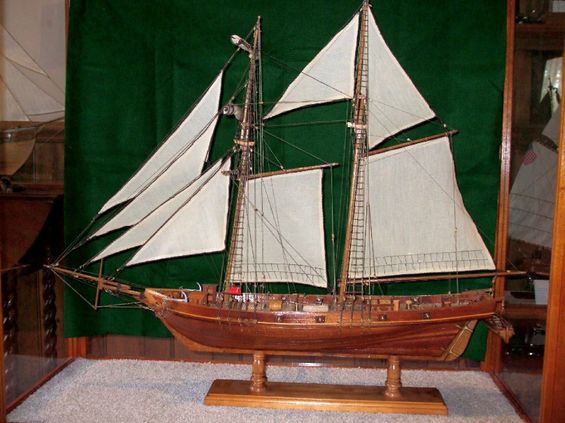Classic Ship Models 10
Baltimore Clipper firing cannon
A PROFILE
of Baltimore Clippers
Originally known as Virginia built boats, the Baltimore Clipper can best be defined by her tall and raking masts with a very low freeboard. They had a great rake at both stem and stern and were flush decked. The design was influenced by the French luggers as well as the Bermuda sloops with their incredible windward abilities. The earlier models were used with great success by the American Navy during the Revolution, being so much more advanced than other vessels of their time.
It was the war of 1812 that made the Baltimore Clippers. After the war, they became the new calling for the slave trade. As they became the pursued rather than the pursuer, more refinements were introduced with larger masts and yards combined with a sharper waterline. When the slave trade was abolished some were used in the opium trade. The design of the Baltimore Clipper was aslo taken up by the pilot schooners.
The model of the "Harvey" shown below depicts a clipper built by William Webb, a well known shipbuilder, in Baltimore in 1847. She was a clipper class vessel of wooden construction, fitted with two masts as were the early clippers. The hull was so designed to reach high speeds with many sails and uncluttered decks. This was to enable maximum cargo could be carried leaving the decks clear for the crew to attend sails with greater freedomof movement. The fierce storms they encountered around Cape Horn demanded the ability of furling and unfurling sails without delay.
In 1848, California was incorporated as a state of the Union. When it was discovered the state was one of extreme wealth, the resulting rush - including the Gold Rush - could only be met by sea using the fastest ships available, such as the "Harvey". Not only was this method of transportation faster than the land route but also less perilous. Some fast times were recorded such as New York to California in 89 days. Some of the cargoes were so valuable that the armaments originally fitted were retained to deal with active pirates. Thanks largely to the clippers, the population of the cities of California, such as San Francisco, trebled in less than ten years.
THE MODEL
THE MODEL
AMERICAN Clipper Ship "Harvey" 1847
This model is from the kit produced by the Spanish kit maker Artesinia Latina. This was my first model, made in the late 1999,
and being the first, probably took longer than the average of later efforts due to the need to research all the information on how to perform the tasks required. The clarity of instructions are so essential for the beginner and for this, Artesinia excel. Other
makers have fine kits but sometimes the language translations are hard to follow or understand.
This model has a 1:50 scale and, as per the "Le Hussard made shortly afterwards, the clear decks and scale size make it easier to handle, particularly when it comes to rigging, making lines fast to the belaying pins and so forth. All good for the beginner. It is an excellent model on which to work and ideal for learning the skills!
From bowsprit to stern, she is 860 mms and 680 mms from keel to topmast. She is both square rigged and fore and aft rigged, and carries eight cannons for defence.


